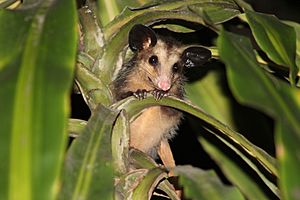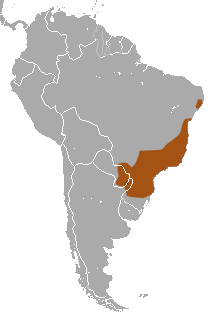Big-eared opossum facts for kids
Quick facts for kids Big-eared opossum |
|
|---|---|
 |
|
| Conservation status | |
| Scientific classification | |
| Genus: |
Didelphis
|
| Species: |
aurita
|
 |
|
| Big-eared opossum range | |
The big-eared opossum (Didelphis aurita), also known as a saruê, is a type of opossum found in South America. These interesting animals live in countries like Argentina, Brazil, and Paraguay.
For a long time, scientists thought the big-eared opossum was just a group of the common opossum (D. marsupialis). However, they are now known to be their own unique species.
Contents
What is a Big-Eared Opossum?
The big-eared opossum gets its name from its noticeably large ears. Like other opossums, it is a marsupial, which means the females carry their babies in a pouch, much like a kangaroo.
Where Do They Live?
Big-eared opossums prefer to live in forests and woodlands. They are often found in areas with lots of trees and plants, which provide them with shelter and food. Their home range stretches across parts of southeastern Brazil, eastern Paraguay, and northeastern Argentina.
What Do They Look Like?
These opossums are usually about the size of a house cat, but with a longer, hairless tail. They have grayish fur, a pointed snout, and those distinctive large ears. Their tails are prehensile, meaning they can use them to grip branches, which helps them climb trees.
Big-Eared Opossum Behavior
Big-eared opossums are mostly active at night, making them nocturnal animals. They spend their nights looking for food and exploring their territory.
What Do They Eat?
These opossums are omnivores, which means they eat both plants and animals. Their diet can include fruits, insects, small birds, eggs, and even small rodents. This varied diet helps them survive in many different environments.
How Do They Raise Their Young?
Female big-eared opossums carry their babies in a pouch after they are born. As the young opossums grow, they often ride on their mother's back. When a female is carrying her offspring, she tends to stay in smaller areas and doesn't move around as much. This helps keep her babies safe.
Conservation Status
The big-eared opossum is currently listed as "Least Concern" by the International Union for Conservation of Nature (IUCN). This means that, for now, their population is stable and they are not considered to be in immediate danger of extinction. However, like many animals, they can be affected by habitat loss and other changes in their environment.
See also
 In Spanish: Zarigüeya brasileña para niños
In Spanish: Zarigüeya brasileña para niños


